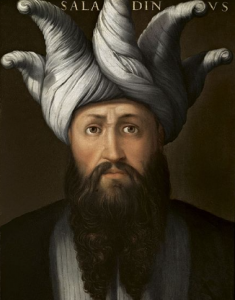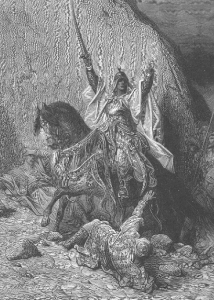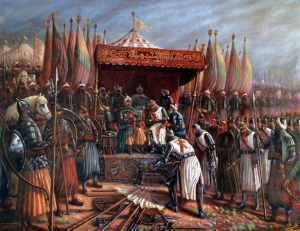Saladin: Biography and Achievements of the Founder of the Ayyubid Dynasty
The Holy Crusades were a pivotal period in the history of European-West Asian interactions. Saladin ranks up there as one of the most important figures of the Third Crusade (1189-1193). Other notable figures of the Third Crusade were Richard I of England (also known as Richard the Lionheart), Frederick I, Holy Roman Emperor (also known as Frederick Barbarossa), and Philip Ii of France (also known as Philip Augustus). During the Third Crusade, which is also known as the Kings’ Crusade, those three Western Christian monarchs fought tirelessly against Saladin and his Ayyubid armies.
We’ll focus on Saladin’s life and how he influenced this critical period.

Saladin ranks up there as one of the most important figures of the Third Crusade (1189-1193). He was born around 1136 in the Castle of Tikrit, which is north of Baghdad.
You’ve probably heard of the Crusades, a series of religious conflicts waged to control the Holy Land between European knights and Islamic troops. This era produced several notable individuals, including Richard the Lionheart. You might wonder against whom these European monarchs and knights were fighting? They were at war with most Islamic kings, but no name rang as loudly across history as Saladin’s. This Islamic sultan of the 12th century, known in Arabic as Yusuf ibn Ayyub ibn Shadi, led vast troops, fought Europeans for control of the Holy Lands, established a new Islamic Empire that would transform the globe, and ended up mending ties between Europe and West Asia.
Early Life
Saladin was born in Tikrit, what is now north of Baghdad, Iraq, in the year 1137 to Sitt Al-Mulk Khatun and Najm Ad-Din Ayyub. His family was of Kurdish heritage and followed the Sunni branch of Islam. His father was a Kurdish soldier and administrator under the employment of the Seljuk Turks.
He seemed to have been well educated from an early age. Although being more of a scholar than a warrior, he was drafted into the military under the supervision of his uncle, Asad al-Din Shirkuh. It was during this time that Saladin saw his first battles.
At the time of Saladin’s birth and early life, the Christian states – namely the Kingdom of Jerusalem, the County of Tripoli, and the Principality of Antioch – were experiencing a very prosperous period as the Muslims could not mount a unified challenge to their presence in the region. Muslim states constantly fought amongst themselves and paid no attention to the invading Christians. All that was about to change with the tactical and diplomatic genius of Saladin.
Saladin In Power
Saladin’s uncle Shirkuh was a loyal and abled general of of the Muslim ruler Nur ad-Din, who had established himself firmly in Damascus. Nur ad-Din’s Zengis dynasty not only ended the Christians’ occupation of Damascus, but he also created a thriving religious center in the city.
Saladin had the rare opportunity of having both Shirkuh and Nur ad-Din as his mentors. Nur ad-Din posted Shirkuh to Egypt to serve as the Vizier of what was formerly the Fatimid Caliphate stronghold.
By 1169, Saladin had achieved enough fame and respect to attract the interest of the caliphs (Islamic rulers) of Egypt’s Fatimid Caliphate. Saladin soon advanced through the official levels; and following his uncle’s death, the young man was appointed Vizier of Egypt.
Since the Fatimids were Shia Muslims and Saladin was Sunni, it was an intriguing move since the two sects rarely shared power.
Saladin, it appears, was not about to squander the chance. He advanced in the Fatimid government, and when the caliph died in 1171, he took office. The Fatimid Caliphate, one of the great medieval Islamic empires, ended in 1171. However, Islamic power was far from complete. Saladin converted Egypt into a Sunni state, linking it with Baghdad’s Sunni Abbasid Caliphate.
The caliph of Baghdad recognized him as the leader of the Sunni faith and governor of Egypt, Yemn and Syria.
Establishment of the Ayyubid Dynasty
In 1174, he invaded and conquered Syria, becoming Sultan of Egypt and Syria. It was a title he would bear for the rest of his life.
He is also known as the founder of Ayyubid dynasty (1171-1260). Saladin toppled the Shi’a Muslim Fatimid Caliphate of Egypt. In 1171, he established his own dynasty, which encompassed large areas of the Levant, northern Iraq, northern Nubia, southern Anatolia, Hejaz and Yemen, among others. His territory of Hijaz, which houses Mecca and Medina – the two holy cities in Islam, made him earn the title “Custodian of the Two Holy Mosques”.
and the establishment of a new Islamic dynasty that would control most of West Asia for the next century. This was known as the Ayyubid Dynasty.
As ruler of Egypt, he made sure he had loyal advisors in his inner circle. He also surrounded himself with competent people. All of those moves augured well for the Egyptian economy. Saladin used those economic gains to increase his power and become a very powerful Muslim ruler.
Saladin’s Crusades

This Sunni Muslim Kurd was the first sultan of Egypt and Syria. Saladin worked tirelessly to create a united Muslim front in order to drive away the Christians from the Levant and Jerusalem in particular. Image: 19th-century depiction of a victorious Saladin, by French painter Gustave Doré
Saladin faced off against Richard the Lionheart’s forces in battle in his early 50s during the Third Crusade (1189-1192). Richard was able to reestablish the Christian Kingdom of Jerusalem during this period because of a series of engagements and a peace treaty with Saladin. Saladin also witnessed the Second Crusade (1147-1150) while living in Damascus, the Zengid capital. The Second Crusade followed the Zengid invasion of the Crusader Kingdom of Edessa in modern-day Turkey.
Political and Military Achievements

After defeating the Crusaders at the Battle of Hattin in 1187, Saladin took possession of the Kingdom of Jerusalem, the prized Crusader state.
Saladin’s life was filled with triumphs, such as retaking Jerusalem from the Crusaders and negotiating a truce with the Assassins (also known as Nizari Ismailis), a group of deadly assassins of Shia Muslims that operated in Persia and Syria.
His most notable achievement, however, was extending his control across a religiously and politically diverse region that included Egypt, Syria, Mesopotamia, and western Arabia. He ruled over those areas until his death, establishing the Ayyubid Dynasty.
He used military and diplomatic maneuvers to bring under his control several local leaders. He also stamped so many rebellions, including the one from Nur ad-Din’s son.
He wisely negotiated a truce with the Byzantines as a means to keep the Seljuk Turks from disrupting his grand plan.
He defeated Guy of Lusignan, king of the Kingdom of Jerusalem, at the Battle of Hattin in 1187.
Saladin was astute in political dealings and never fell into the traps of the enemy. He was suspicious when King Richard offered to marry his sister, Jane, to Saladin’s brother, Malik’ Adil, to end the struggle between Christians and Muslims. He did not fall for this ruse since King Richard had indicated that Malik’ Adil had to convert to Christianity to marry. Saladin recognized that if the marriage went ahead, he would lose his faith and the trust of his people.
The Treaty of Jaffa
Having captured Jerusalem, which prompted the Third Crusade, Saladin was able to hold the Christian soldiers. Following the Battle of Jaffa in 1192, which was one of the last major military confrontations of the Third Crusade, Saladin and Richard the Lionheart a deal – the Treaty of Jaffa on September 2 1192 – which meant Muslim control over Jerusalem. In the deal, unarmed Christian pilgrims and merchants would be allowed to visit the Holy City. The three years that followed did not see any major confrontations between Saladin’s forces and the Crusaders.
Infrastructure and Citadels
In the medieval times, Citadels were critical in protecting people from outsider attacks. Egypt, for example, was in a strategic position and was always a target for invaders. Massive waves of attacks by either the Saljuqi or the Franks occurred during the 11th century.
When Saladin came to power in Egypt, he saw the citadel as crucial to the defense of his people. In 1176, he prudently opted to construct a castle between Qahira and Fustat to protect and oversee both cities. He also built a defensive wall around these two cities in order to unite them.
Saladin’s brilliance was displayed in his design of a massive rectangular well located in the citadels. This meant that the water would not run out even if the city was encircled by foes.
Health Centers
Saladin’s other outstanding achievement was the establishment of hospitals known as Bimar-i-stan. In the hospital, a scientist had a supply of drugs that he could utilize and provide to patients. There were also three wards, each with numerous patient rooms and beds. Inside the hospital were two wards for men and women; aside from the scientist, another attendant serviced the patients.
The Muslim ruler was interested in science and helped to develop the towns of Cairo and Damascus, which became prospered during his reign. Both cities also became important trading centers, particularly Damascus, which became the principal trade center for wool and swords.
Saladin also founded four schools for Mazahib followers (Shafi’, Hanafi, Malki, and Hanbili) and four schools for other sorts of study during his reign in Egypt and the Levant.
Just Rule
During Saladin’s reign, his judges spread throughout the Ayybian dynasty’s domain. Saladin’s justice was fair and unbiased, and many benefited from it. Saladin gained a lot of respect in return, which was a huge accomplishment for him. Despite the disputes throughout the realm, there is no evidence that his people suffered starvation, and there was no peasant insurrection against Saladin. However, many rebellions were carried out during the other dynasties. Saladin’s treasure was immeasurable when he captured the palace of Califa al-‘Adil. Instead of hoarding it, he gave this resource to his people and used it for the public good.
Saladin as a peacemaker
Despite the hostility between Muslims and Christians for about 100 years due to the crusades, Saladin established peace between them. When Saladin and King Richard negotiated a peace treaty between Muslims and Christians, both maintained their word unconditionally. When the crusader army returned home, many Christians stayed in Jerusalem and the Middle East. Saladin kept the peace between them, and no violence occurred.
Saladin also repealed the Jezia on non-Muslims and replaced it with alms (Zakat). Christians and Jews paid the Jezia to Muslims in order to maintain their faith and keep the peace. In contrast, Muslims paid a Zakat from their earnings which felt more honorable.
Personal Life
Saladin married Ismat ad-Din Khatun, who was previously married to Nur ad-Din, but following the death of the ‘Zengid’ emperor in 1174, she married the ‘Ayyubid’ monarch, Saladin. This ensured that Saladin could be associated with two ruling dynasties since Ismat was the daughter of a previous governor in Damascus.
Cause of Death

Saladin’s sarcophagus within the tomb building.
Saladin died from a fever on March 4, 1193. His death came not long after King Richard had left Jerusalem. It’s been stated that Saladin had one piece of gold and forty pieces of silver in his possession at the time of his death since he had given away his vast wealth to his destitute citizens. There was even no personal funds of his to cover his funeral expenses.
The sultan was laid to rest in a tomb near the Umayyad Mosque in Damascus, Syria. He was survived by seventeen sons and one daughter.
Other Notable Facts about Saladin
- Saladin went by the epithet the ‘Righteous of the Faith’.
- His uncle Shirkuh (Asad ad-Din Shirkuh bin Shadhi) was known as the “Lion of the Mountains”. His uncle was an astute general and politician. He is credited with laying the structures upon which Saladin would use to consolidate and expand his power in Egypt.
- Recognized as the most famous Kurd in history, Saladin achieved a feat that was never previously achieved. He used his military and political prowess to bring the Muslims in the region to fight against the invading Christians during the Third Crusade.
- He was praised for his generosity, chivalry and kindness, including to his foes. This trait of his made him a revered figure by both Christians and Muslims in the medieval era. In the west, he came to be seen as a chivalrous knight.
- Richard the Lionheart had strong admiration for Saladin, calling the Muslim sultan a great prince and the most renowned leader in the Islamic world.
- Following Saladin’s death, the Sultan’s sons split the empire amongst themselves. This divisions weakened the power of the Saladin’s sultanate. Thus, Saladin’s Ayyubid dynasty collapsed about half a century after his death.
Did you know?
- The Eagle of Saladin serves as an important symbol for Arab nationalists. The symbol even appears in the Egyptian coat of arms. He is held dearly in Turkish, Kurdish and Arab culture.
- Wilhelm II, the last German Emperor and King of Prussia, paid a visit to Saladin’s tomb in 1898.
- Dante’s “The Divine Comedy” portrays Saladin as one of the pious non-Christians that dwell in limbo.
























